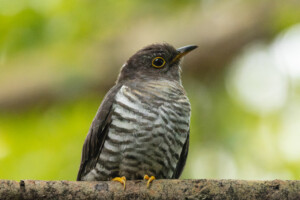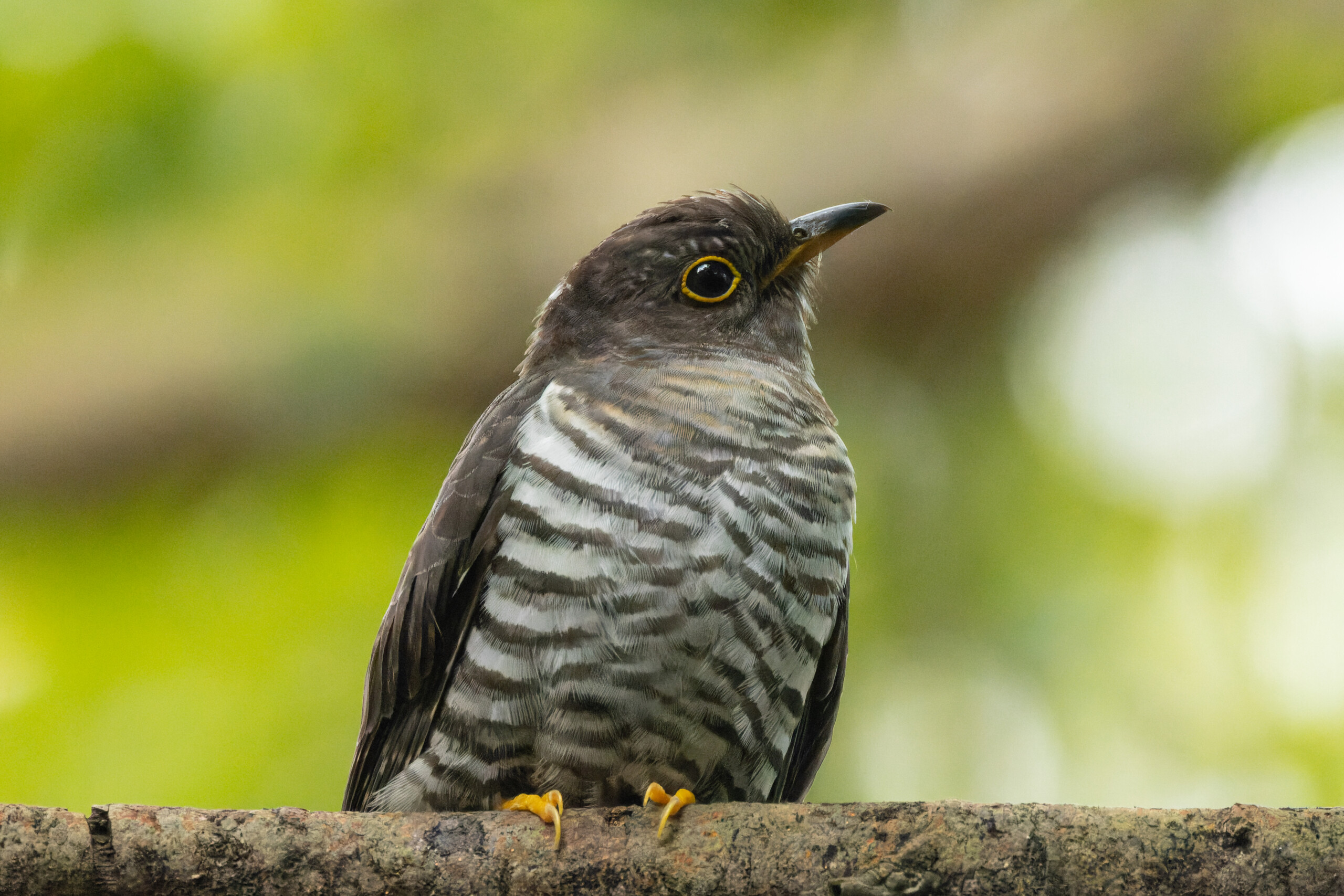
LINKED PAPER
Acoustic niche partitioning among seven cuckoo species in a forest in eastern China. Mei, J., Puswal, S. M., Wang, M., Liu, F. 2024. IBIS. DOI: 10.1111/ibi.13228. VIEW
Birds often rely on acoustic signals to attract mates and defend territories, but what if every other bird in the neighbourhood is also trying to attract attention? How can a bird avoid acoustic interference? The ‘acoustic niche hypothesis’ (Krause 1993) states that closely related species partition their signals in acoustic niche space to reduce overlap with other individuals or species (Villanueva-Rivera 2014). Acoustic niches have been studied extensively not only across birds, but also anurans, insects, and fish. However, within birds much of the focus on acoustic niche partitioning has been on passerines.
In a recent study in Ibis, Jinjuan Mei and colleagues explored acoustic niches in seven sympatric cuckoo species in a subtropical forest in China, to investigate whether there is niche competition or separation in their acoustic activity.
Acoustic niche dimensions
The world can be very noisy, with not only biotic sounds (such as birdsong and insect sounds) but also abiotic and anthropogenic sounds, all of which can overlap and interfere with acoustic signalling. The acoustic niche has three dimensions: frequency, space, and time (Garcia-Rutledge & Narins 2001). While birds have been shown to be able to shift their song frequencies to avoid being masked, their body size, phylogeny, and morphology act as limitations on how much frequency can be altered (Ryan & Brenowitz 1985). Strategies such as changing call times (e.g. Cody & Brown 1969) and perch heights (e.g. Nemeth et al. 2001) have also been demonstrated in different bird species.
As well as reducing interference, acoustic adaptation to habitat features may lead to community convergence, whereby the acoustic features of species in the same community are expected to be more clustered than random (Planqué & Slabbekoorn 2008).
The seven cuckoo species examined in this study were: Indian Cuckoo Cuculus micropterus, Himalayan Cuckoo Cuculus saturatus, Common Cuckoo Cuculus canorus, Lesser Cuckoo Cuculus poliocephalus, Asian Koel Eudynamys scolopaceus, Large Hawk-Cuckoo Hierococcyx sparverioides and Chestnut-winged Cuckoo Clamator coromandus. These brood parasites are sympatric during the relatively short breeding season in eastern China, and previous studies have indicated overlaps in spatial distributions, ecological niches, and host species (Yang et al. 2012). The researchers calculated the overlap of frequency range between each pair of species and used a linear discriminant analysis model of acoustic features of the vocalisations to investigate whether there is partitioning in acoustic signal space. A null model method was used to generate random communities and check the dispersal/aggregation of acoustic feature distributions, and the researchers calculated the overlap of the temporal distribution and actual-time, as well as looking for differences in acoustic parameter distances between pair-wise species combinations within and between the four represented genera.

Figure 1. Frequency range occupied by each species at each site in Yaoluoping National Nature Reserve (China).
Partitioning in acoustic signal space
Results showed that, out of 21 species pairs, four overlapped in frequency range. However, most of the seven species occupied distinct acoustic signal spaces, and these four species pairs could be separated in the temporal or spatial dimensions. The acoustic parameters in the observed community were more dispersed than expected by chance, which has also been shown in other studies of the vocal activity of sympatric species. The results also suggested that phylogenetic distance has only a small effect on acoustic distance, spectral overlap, and temporal overlap among species pairs.

Figure 2. Principal component space (PC1 and PC2) of the calls of seven cuckoo species in Yaoluoping National Nature Reserve (China). Most species occupy a distinct region in this two-dimensional space.
Most of the study species aggregated their vocal activity at dawn and dusk, suggested to potentially be related to abiotic factors, reduced predation risk, and/or reduced interference with insect noise. Further research could examine seasonal patterns in acoustic activity by using a longer timeframe than the two weeks of data collected in this study, which limited the investigation of seasonal distribution partitioning among species. The results suggested that the species distribute their vocalisations within a similar broad time range but do not call simultaneously, which may be due to individuals avoiding overlaps by starting their song as soon as another bird has finished (Cody & Brown 1969).
Overall, the seven sympatric cuckoo species were strongly partitioned in acoustic signal space, with the researchers suggesting that they may have flexible mechanisms to partition their acoustic niche in multiple dimensions (Chitnis et al. 2020)
References
Chitnis, S.S., Rajan, S. & Krishnan, A. (2020). Sympatric wren-warblers partition acoustic signal space and song perch height. Behavioral Ecology 31: 559–567. VIEW
Cody, M.L. & Brown, J.H. (1969). Song asynchrony in neighbouring bird species. Nature 222: 778–780. VIEW
Garcia-Rutledge, E.J. & Narins, P.M. (2001). Shared acoustic resources in an old world frog community. Herpetologica 57: 104–116. VIEW
Krause, B.L. (1993). The niche hypothesis: A virtual symphony of animal sounds, the origins of musical expression and the health of habitats. The Soundscape Newsletter 6: 6–10. VIEW
Nemeth, E., Winkler, H. & Dabelsteen, T. (2001). Differential degradation of antbird songs in a neotropical rainforest: adaptation to perch height? Journal of the Acoustical Society of America 110: 3263–3274. VIEW
Planqé, R. & Slabbekoorn, H. (2008). Spectral overlap in songs and temporal avoidance in a Peruvian bird assemblage. Ethology 114: 262–271. VIEW
Ryan, M.J. & Brenowitz, E.A. (1985). The role of body size, phylogeny, and ambient noise in the evolution of bird song. The American Naturalist 126: 87–100. VIEW
Villanueva-Rivera, L.J. (2014). Eleutherodactylus frogs show frequency but no temporal partitioning: Implications for the acoustic niche hypothesis. PeerJ 2: e496. VIEW
Yang, C., Liang, W., Antonov, A. & Cai, Y. (2012). High diversity of brood parasites in China and coevolution between cuckoos and their hosts. Chinese Birds 3: 9–32. VIEW
Image credits
Top right: Lesser Cuckoo | Tisha Mukherjee | CC BY-SA 4.0 Wikimedia Commons
Blog posts express the views of the individual author(s) and not those of the BOU.
If you want to write about your research in #theBOUblog, then please see here





